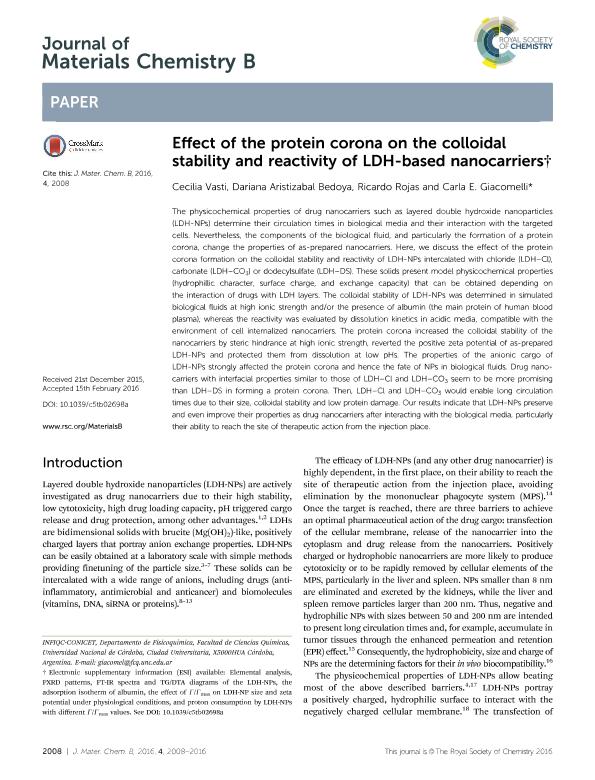Mostrar el registro sencillo del ítem
dc.contributor.author
Vasti, Cecilia

dc.contributor.author
Aristizabal, Dariana

dc.contributor.author
Rojas Delgado, Ricardo

dc.contributor.author
Giacomelli, Carla Eugenia

dc.date.available
2018-06-06T17:23:00Z
dc.date.issued
2016-03-15
dc.identifier.citation
Vasti, Cecilia; Aristizabal, Dariana; Rojas Delgado, Ricardo; Giacomelli, Carla Eugenia; Effect of the protein corona on the colloidal stability and reactivity of LDH-based nanocarriers; Royal Society of Chemistry; Journal of Materials Chemistry B; 4; 11; 15-3-2016; 2008-2016
dc.identifier.issn
2050-750X
dc.identifier.uri
http://hdl.handle.net/11336/47491
dc.description.abstract
The physicochemical properties of drug nanocarriers such as layered double hydroxide nanoparticles (LDH-NPs) determine their circulation times in biological media and their interaction with the targeted cells. Nevertheless, the components of the biological fluid, and particularly the formation of a protein corona, change the properties of as-prepared nanocarriers. Here, we discuss the effect of the protein corona formation on the colloidal stability and reactivity of LDH-NPs intercalated with chloride (LDH-Cl), carbonate (LDH-CO3) or dodecylsulfate (LDH-DS). These solids present model physicochemical properties (hydrophillic character, surface charge, and exchange capacity) that can be obtained depending on the interaction of drugs with LDH layers. The colloidal stability of LDH-NPs was determined in simulated biological fluids at high ionic strength and/or the presence of albumin (the main protein of human blood plasma), whereas the reactivity was evaluated by dissolution kinetics in acidic media, compatible with the environment of cell internalized nanocarriers. The protein corona increased the colloidal stability of the nanocarriers by steric hindrance at high ionic strength, reverted the positive zeta potential of as-prepared LDH-NPs and protected them from dissolution at low pHs. The properties of the anionic cargo of LDH-NPs strongly affected the protein corona and hence the fate of NPs in biological fluids. Drug nanocarriers with interfacial properties similar to those of LDH-Cl and LDH-CO3 seem to be more promising than LDH-DS in forming a protein corona. Then, LDH-Cl and LDH-CO3 would enable long circulation times due to their size, colloidal stability and low protein damage. Our results indicate that LDH-NPs preserve and even improve their properties as drug nanocarriers after interacting with the biological media, particularly their ability to reach the site of therapeutic action from the injection place.
dc.format
application/pdf
dc.language.iso
eng
dc.publisher
Royal Society of Chemistry

dc.rights
info:eu-repo/semantics/openAccess
dc.rights.uri
https://creativecommons.org/licenses/by-nc-sa/2.5/ar/
dc.subject
Layered Double Hydroxide
dc.subject
Nanoparticles
dc.subject
Protein Corona
dc.subject.classification
Otras Ciencias Químicas

dc.subject.classification
Ciencias Químicas

dc.subject.classification
CIENCIAS NATURALES Y EXACTAS

dc.title
Effect of the protein corona on the colloidal stability and reactivity of LDH-based nanocarriers
dc.type
info:eu-repo/semantics/article
dc.type
info:ar-repo/semantics/artículo
dc.type
info:eu-repo/semantics/publishedVersion
dc.date.updated
2018-05-07T18:03:47Z
dc.identifier.eissn
2050-7518
dc.journal.volume
4
dc.journal.number
11
dc.journal.pagination
2008-2016
dc.journal.pais
Estados Unidos

dc.description.fil
Fil: Vasti, Cecilia. Consejo Nacional de Investigaciones Científicas y Técnicas. Centro Científico Tecnológico Conicet - Córdoba. Instituto de Investigaciones en Físico-química de Córdoba. Universidad Nacional de Córdoba. Facultad de Ciencias Químicas. Instituto de Investigaciones en Físico-química de Córdoba; Argentina
dc.description.fil
Fil: Aristizabal, Dariana. Consejo Nacional de Investigaciones Científicas y Técnicas. Centro Científico Tecnológico Conicet - Córdoba. Instituto de Investigaciones en Físico-química de Córdoba. Universidad Nacional de Córdoba. Facultad de Ciencias Químicas. Instituto de Investigaciones en Físico-química de Córdoba; Argentina
dc.description.fil
Fil: Rojas Delgado, Ricardo. Consejo Nacional de Investigaciones Científicas y Técnicas. Centro Científico Tecnológico Conicet - Córdoba. Instituto de Investigaciones en Físico-química de Córdoba. Universidad Nacional de Córdoba. Facultad de Ciencias Químicas. Instituto de Investigaciones en Físico-química de Córdoba; Argentina
dc.description.fil
Fil: Giacomelli, Carla Eugenia. Consejo Nacional de Investigaciones Científicas y Técnicas. Centro Científico Tecnológico Conicet - Córdoba. Instituto de Investigaciones en Físico-química de Córdoba. Universidad Nacional de Córdoba. Facultad de Ciencias Químicas. Instituto de Investigaciones en Físico-química de Córdoba; Argentina
dc.journal.title
Journal of Materials Chemistry B
dc.relation.alternativeid
info:eu-repo/semantics/altIdentifier/url/http://pubs.rsc.org/en/Content/ArticleLanding/2016/TB/C5TB02698A
dc.relation.alternativeid
info:eu-repo/semantics/altIdentifier/doi/http://dx.doi.org/10.1039/C5TB02698A
Archivos asociados
